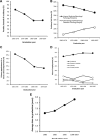Are MD-PhD programs meeting their goals? An analysis of career choices made by graduates of 24 MD-PhD programs
- PMID: 20186033
- PMCID: PMC4441397
- DOI: 10.1097/ACM.0b013e3181d3ca17
Are MD-PhD programs meeting their goals? An analysis of career choices made by graduates of 24 MD-PhD programs
Abstract
Purpose: MD-PhD training programs provide an integrated approach for training physician-scientists. The goal of this study was to characterize the career path taken by MD-PhD program alumni during the past 40 years and identify trends that affect their success.
Method: In 2007-early 2008, 24 programs enrolling 43% of current trainees and representing half of the National Institutes of Health-funded MD-PhD training programs submitted anonymous data on 5,969 current and former trainees.
Results: The average program enrolled 90 trainees, required 8.0 years to complete, and had an attrition rate of 10%. Nearly all (95%) of those who graduated entered residencies. Most (81%) were employed in academia, research institutes, or industry; 16% were in private practice. Of those in academia, 82% were doing research and at least 61% had identifiable research funding. Whereas two-thirds devoted more than 50% effort to research, only 39% devoted more than 75% effort. Many with laboratory-based PhDs reported doing clinical, as well as basic and translational, research. Emerging trends include decreasing numbers of graduates who forego residencies or hold primary appointments in nonclinical departments, increasing time to graduation, and expanding residency choices that include disciplines historically associated with clinical practice rather than research.
Conclusions: Most MD-PhD program graduates follow career paths generally consistent with their training as physician-scientists. However, the range of their professional options is broad. Further thought should be given to designing their training to anticipate their career choices and maximize their likelihood of success as investigators.
Figures



Comment in
-
The urgent need to increase support for the NIH's MD-PhD student fellowships.Acad Med. 2011 Mar;86(3):277; author reply 277-8. doi: 10.1097/ACM.0b013e3182084542. Acad Med. 2011. PMID: 21346431 No abstract available.
Similar articles
-
Characteristics and career intentions of the emerging MD/PhD workforce.JAMA. 2008 Sep 10;300(10):1165-73. doi: 10.1001/jama.300.10.1165. JAMA. 2008. PMID: 18780845
-
The national MD-PhD program outcomes study: Relationships between medical specialty, training duration, research effort, and career paths.JCI Insight. 2019 Oct 3;4(19):e133009. doi: 10.1172/jci.insight.133009. JCI Insight. 2019. PMID: 31578310 Free PMC article.
-
The first nationwide survey of MD-PhDs in the social sciences and humanities: training patterns and career choices.BMC Med Educ. 2017 Mar 21;17(1):60. doi: 10.1186/s12909-017-0896-1. BMC Med Educ. 2017. PMID: 28327141 Free PMC article.
-
Retaining clinician-scientists: nature versus nurture.Invest Ophthalmol Vis Sci. 2014 May 27;55(5):3219-22. doi: 10.1167/iovs.14-14605. Invest Ophthalmol Vis Sci. 2014. PMID: 24867910 Review.
-
Diversity in MD-PhD Programs and Factors Affecting Admission and Completion Among Minoritized Groups: A Scoping Review.Acad Med. 2023 Mar 1;98(3):410-419. doi: 10.1097/ACM.0000000000005010. Epub 2022 Oct 4. Acad Med. 2023. PMID: 36205493
Cited by
-
The clinician-scientist track: an approach addressing Australia's need for a pathway to train its future clinical academic workforce.BMC Med Educ. 2018 Oct 3;18(1):227. doi: 10.1186/s12909-018-1337-5. BMC Med Educ. 2018. PMID: 30285826 Free PMC article.
-
Is an MD/PhD program right for me? Advice on becoming a physician-scientist.Mol Biol Cell. 2018 Apr 15;29(8):881-885. doi: 10.1091/mbc.E17-12-0721. Mol Biol Cell. 2018. PMID: 29668419 Free PMC article.
-
Editorial: The vulnerable physician-scientist.Mol Endocrinol. 2014 May;28(5):603-6. doi: 10.1210/me.2014-1085. Mol Endocrinol. 2014. PMID: 24786416 Free PMC article. No abstract available.
-
Incubating the research independence of a medical scientist training program graduate: a case study.Acad Med. 2015 Feb;90(2):176-9. doi: 10.1097/ACM.0000000000000568. Acad Med. 2015. PMID: 25406610 Free PMC article.
-
A comparative analysis of the doctoral regulations at the medical faculties in Germany.Int J Med Sci. 2024 Feb 12;21(4):732-741. doi: 10.7150/ijms.92167. eCollection 2024. Int J Med Sci. 2024. PMID: 38464831 Free PMC article.
References
-
- Ley TJ, Rosenberg LE. The physician–scientist career pipeline in 2005: Build it, and they will come. JAMA. 2005;294:1343–1351. - PubMed
-
- National Institute of General Medical Sciences [November 25, 2009];MSTP study: The careers and professional activities of graduates of the NIGMS Medical Scientist Training Program. Available at: http://publications.nigms.nih.gov/reports/mstpstudy/#10.
-
- Martin JB. Training physician–scientists for the 1990s. Acad Med. 1991;66:123–129. - PubMed
MeSH terms
Grants and funding
LinkOut - more resources
Full Text Sources
Other Literature Sources
Miscellaneous

